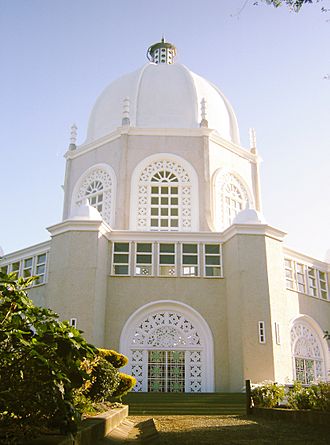Sydney Baháʼí Temple facts for kids
Quick facts for kids Sydney Baháʼí Temple |
|
|---|---|
 |
|
| General information | |
| Type | Baháʼí House of Worship |
| Location | Ingleside, Sydney, Australia |
| Coordinates | 33°41′08″S 151°15′31″E / 33.6855°S 151.2587°E |
| Completed | 16 September 1961 |
| Height | 38 metres (125 ft) |
| Dimensions | |
| Diameter | 20 metres (66 ft) |
| Design and construction | |
| Architect | Mason Remey, John Brogan |
| Other information | |
| Seating capacity | 600 |
The Sydney Baháʼí House of Worship, also known as the Sydney Baháʼí Temple, is a special building located in Ingleside, a suburb north of Sydney, Australia. It is considered one of Sydney's most important religious buildings built in the 1900s.
This temple was the fourth Baháʼí House of Worship ever built in the world, and it was finished in 1961. Shoghi Effendi, who was the head of the Baháʼí Faith at the time, called it the "Mother Temple of the whole Pacific area." Each year, more than 20,000 people from Australia and other countries visit this beautiful temple.
Contents
History of the Temple
Planning and Building
In the early 1950s, the Baháʼís in Australia started looking for a place to build their House of Worship. Around 1955, due to difficult times for Baháʼís in Iran, plans for a temple there were paused. Instead, two new temples were planned: one in Kampala, Uganda, and the other in Sydney.
The land for the Sydney temple was bought in 1956. The first design was made by Mason Remey, and then Sydney architect John Brogan helped develop and complete it. Construction began in April 1957. A special ceremony was held on March 22, 1958. Clara Dunn, who helped bring the Baháʼí Faith to Australia in 1920, attended this event.
Opening and Celebrations
The temple officially opened on September 16 and 17, 1961. Rúhíyyih Khánum, who was Shoghi Effendi's wife, led the dedication ceremony. Important guests from around the world also attended a special party hosted by the mayor of Sydney.
The building's design and construction were featured in engineering magazines. News about the temple also appeared in Australian newspapers like The Daily Telegraph and The Sydney Morning Herald. The total cost to build the temple over four years was about £150,000, which was a large sum of money back then.
Challenges and Anniversaries
The temple faced threats from nearby bushfires in the summers of 1993–1994 and 2005–2006. Luckily, the fires came close but never reached the temple grounds.
In 2011, the temple celebrated its 50th anniversary with a week of events. These included a prayer service where people from different religions came together. The Premier of New South Wales also attended a reception. There was even an art exhibition featuring children's artwork about creating a more peaceful world.
Building and Gardens
Inside the Temple
The main part of the temple is on the ground floor. It has a large room where 600 people can sit. This room is surrounded by a gallery. There are nine doors that open from this room to the outside gardens. These nine doors are important in all Baháʼí Houses of Worship. They represent the idea that all the world's religions are united.
On the second level, there are windows that let in a lot of light. Above these windows is a beautiful dome. This dome is 20 meters wide and reaches 38 meters high from the ground. A small lantern sits on top of the dome. It was placed there by a helicopter during construction! The temple was built using materials like crushed quartz, local Australian hardwoods for the inside, and concrete and marble for the dome.
Location and Surroundings
The temple is a very noticeable landmark because it sits on the highest point above Sydney's Northern Beaches. From here, you can see the Pacific coast at Mona Vale. It is located on Mona Vale Road, surrounded by natural bushland. This area is also part of an Indigenous Protected Area.
The gardens around the temple are filled with many native Australian plants. You can find beautiful waratahs, three types of eucalypts, caleyi and other grevillea plants, acacia, and woody pear trees.
Visitor Facilities
The temple grounds also have other useful places for visitors. There is a visitors' centre where you can learn more about the temple. You can also find a bookshop and a picnic area. The offices for the Australian Baháʼí community are also located here. In the future, as more Baháʼís live in Australia, there are plans to build centers for education and helping others around the temple.
Worship and Services
The Baháʼí Faith teaches that a Baháʼí House of Worship should be a place for everyone to come together. People of all religions can gather there to think, pray, and worship. Anyone is welcome to enter the Sydney temple, no matter their religious background or other differences.
What Happens Inside
Inside the temple, people can read or chant from the sacred writings of the Baháʼí Faith and other religions. These readings can be in any language. However, reading texts that are not from holy books is not allowed. Also, there are no speeches or fundraising events inside.
Choirs can sing musical versions of prayers and readings. But, no musical instruments are allowed to be played inside the temple. There are no strict rules for how worship services are done, and no special ceremonies are performed.
Public Services
On Sundays and on Baháʼí Holy Days, the temple holds public prayer services. During these services, passages from the holy books of different religions are read. The temple choir also sings beautiful a cappella music, which means they sing without any instruments.
Images for kids



